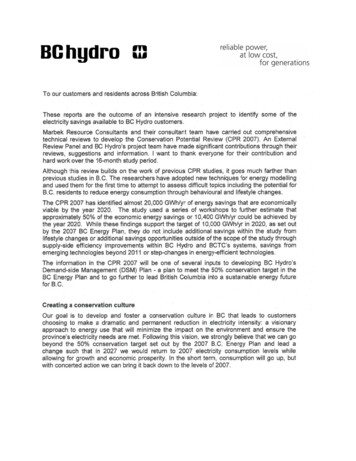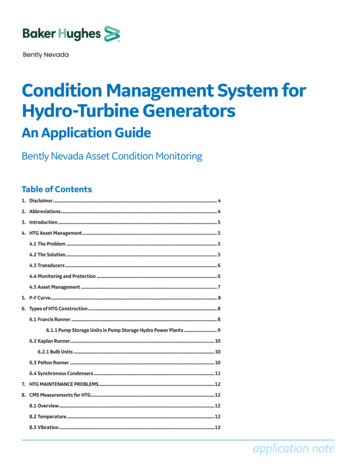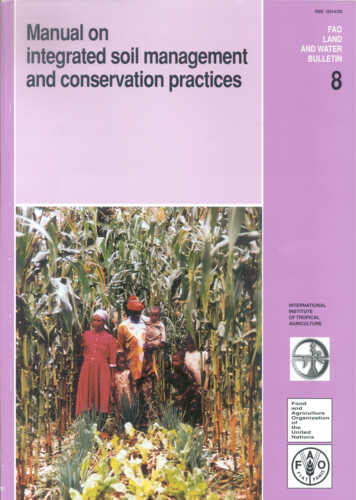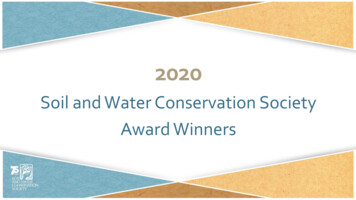
Transcription
BC Hydro2007 CONSERVATION POTENTIAL REVIEWThe Potential for Electricity Savings, 2006 – 2026Residential, Commercial and Industrial Sectorsin British Columbia– Summary Report –Submitted to:BC HydroSubmitted by:Marbek Resource Consultants Ltd.November 20, 2007Marbek Resource Consultants Ltd.300-222 Somerset Street WestOttawa, ON K2P 2G3Tel: 613.523.0784 Fax: 613.523.0717 www.marbek.ca
BC Hydro Conservation Potential Review 2007– Summary –ACKNOWLEDGEMENTSCompletion of the Conservation Potential Review 2007 on an accelerated timetable is due in nosmall part to the consistent input from many BC Hydro staff members, External Review Panelmembers, as well as the hard work of the Consultant Team engaged by BC Hydro. The heaviestwork load fell on the Conservation Potential Review Core Group and the External Review Panel,which oversaw the management of the study.BC HYDRO PROJECT TEAMMurray Bond – Manager of Evaluation, Measurement and Verification, Power SmartChristine Gustafson – Manager of Market Analysis and Information, Power SmartZechy Khoo – Quality Assurance, Power SmartDerek Henriques – Manager of Evaluation, Measurement and Verification, Power SmartSteve Hobson – Manager of Strategic Planning, Power SmartRandy Reimann – Manager of Resource Planning, Energy PlanningKristin Hanlon – Manager of Business, Regulatory and Policy, Energy PlanningGraham Henderson – Engineering, Power SmartAltaf Hussain – Manager of Strategic Resource Planning, Field OperationsDavid Ince – Manager of Portfolio Risk, Market ForecastDennis Nelson – Manager of Business Systems, Power SmartJim Nelson – Manager of Marketing, Power SmartCynthia Lee – Manager of Strategic Resource Planning, Power SmartRon Sanderson – British Columbia Transmission CorporationKen Tiedemann – Manager of Evaluation, Power SmartCindy Verschoor – Community Relations Manager, Stakeholder Engagement, Corporate AffairsMarbek Resource Consultants Ltd.Page i
BC Hydro Conservation Potential Review 2007– Summary –EXTERNAL REVIEW PANELA number of organizations in B.C. agreed to serve on an External Review Panel. They providedinput on project scope and methodology, participated in workshops and reviewed andcommented on draft reports. However, their participation on the Panel should not be construed asindicating full agreement with, or endorsement of, any of the CPR 2007 reports. The ExternalReview Panel was facilitated by Nancy Cooley of Nancy J. Cooley and Associates, Victoria.Members of the Panel include:B.C. Sustainable Energy Association – Kevin Pegg*Building Owners’ and Managers’ Association of B.C. – Len HorvathCanadian Home Builders’ Association of B. C. – Robert BarryCommercial Energy Consumers of B.C. – David CraigDavid Suzuki Foundation – Nicholas HeapFortisBC – Keith VeermanIndependent Power Producers Association of BC – David Kiess* and Barbara Docherty*Joint Industry Electricity Steering Committee – Dan Potts* and Ian May*Kwantlen University College – Tom KnoxMalaspina University-College – Steven EarleMinistry of Energy, Mines and Petroleum Resources – Andrew Pape-Salmon* (Ex Officio)Nisga’a Lisms Government – Mansell GriffinSierra Club of Canada, B.C. Chapter – Tom HackneyTerasen Gas – Sarah SmithUniversity of British Columbia – Colleen Brown*West Fraser Mills – Dave HumberDavid Isaac – StudentCasey Jarvis – Residential CustomerDon Scarlett – Residential CustomerBC Hydro – Steve Hobson (Ex Officio) and Murray Bond (Ex Officio)* These individuals were involved for part of the CPR 2007 study period.Guests of the Panel in attendance at one or more meetings include:Catalyst – Paul Einarson and Frank SlaterJoint Industry Electricity Steering Committee – Pierre LamarcheMayor of Hudson’s Hope – Lenore HarwoodMayor of Dawson Creek – Calvin KrukMinistry of Energy, Mines and Petroleum Resources – Michael D’Antoni and Liz KellyPoyry Vancouver Inc. – Michael JacksonMarbek Resource Consultants Ltd.Page ii
BC Hydro Conservation Potential Review 2007– Summary –OTHER BC HYDRO STAFFIn addition, there were many other BC Hydro staff who reviewed draft reports, participated inmeetings, and/or provided support for the project. In particular we would like to thank theStakeholder Engagement, Power Smart Evaluation, Market Forecast, Power Smart Marketing,Power Smart Engineering, Transmission Services, Resource Planning, Engineering, AboriginalRelations, Generation Strategy and Investment, Power Smart Strategic Planning, and DigitalCommunications groups.Marbek Resource Consultants Ltd.Page iii
BC Hydro Conservation Potential Review 2007– Summary –CONSULTANTSThe Conservation Potential Review 2007 was completed by a team of consultants lead by PaulRobillard of Marbek Resource Consultants Ltd. (Ottawa, Ontario). Consultants and subconsultants were:Residential sector: Dave Shipley and Katie Gent of Marbek Resource Consultants Ltd. and JoeLopes of Applied Energy Group Inc. (New York, N.Y.), conducted the research, modelling andanalysis of the Residential sector, with the assistance of Fred Schwartz of Intellergy Corporation(San Francisco, Cal.), Ken Cooper of SAR Engineering (Victoria, B.C.), and Doug Overholt ofDL Overholt Management.Commercial sector: Richard Patterson and Chris Pulfer of Marbek Resource Consultants Ltd.and Joe Lopes of Applied Energy Group Inc. conducted the research, modelling and analysis ofthe Commercial sector, with the assistance of Fred Schwartz of Intellergy Corporation, and CurtHepting of Enersys Analytics Inc. (Coquitlam B.C.).Industrial sector: Paul Willis and Anthea Jubb of Willis Energy Services Ltd. (Vancouver,B.C.), and Joe Lopes of Applied Energy Group Inc. conducted the research, modelling andanalysis of the Industrial sector, with assistance of Marbek Resource Consultants Ltd.Behaviour: Jay Kassirer of Cullbridge Marketing and Communications (Ottawa, Ont.), JackHabart of Habart and Associates Consulting Inc. (North Vancouver, B.C.) conducted theresearch, modelling and analysis, with the assistance of Loren Lutzenhiser of LutzenhiserAssociates (Portland, Ore.), Mithra Moezzi of Ghoulem Research (San Rafael, Cal.), and MarbekResource Consultants Ltd.Fuel Switching: Dave Shipley and Richard Patterson of Marbek Resource Consultants Ltd. andPaul Willis and Anthea Jubb of Willis Energy Services Ltd. conducted the research, modellingand analysis, with the assistance of Curt Hepting of Enersys Analytics Inc., Joe Lopes of AppliedEnergy Group Inc., and Ken Cooper of SAR Engineering.Customer-supplied Renewable Energies: Innes Hood of the Sheltair Group (Vancouver, B.C.)conducted the research, modelling and analysis, with the assistance of Fred Schwartz ofIntellergy Corporation and Marbek Resource Consultants Ltd.Lifestyle: Dave Biggs of Envision Sustainability Tools Inc. (Vancouver, B.C.) conducted theresearch, modelling and analysis, with the assistance of Mithra Moezzi of Ghoulem Researchand Marbek Resource Consultants Ltd.Marbek Resource Consultants Ltd.Page iv
BC Hydro Conservation Potential Review 2007– Summary –TABLE OF CONTENTS1.INTRODUCTION.11.11.21.31.41.52.SUMMARY OF FINDINGS .82.12.22.32.42.52.63.Approach. 26Summary of Electric Energy Savings . 27Summary of Electric Peak Load Reductions . 30Additional information. 31CUSTOMER-SUPPLIED RENEWABLE ENERGIES.326.16.26.36.47.Approach. 20Summary of Electric Energy savings. 21Summary of Electric Peak Load Savings. 24Additional Information . 25THE INDUSTRIAL SECTOR.265.15.25.35.46.Approach. 15Summary of Electric Energy Savings . 16Summary of Peak Load Savings . 18Additional Information . 19THE COMMERCIAL SECTOR.204.14.24.34.45Electric Energy Savings. 8Electric Peak Load Savings . 10Greenhouse Gas Emission Impacts. 12Energy Efficiency Investment F2026 . 13Additional Information . 14Caveats. 14THE RESIDENTIAL SECTOR .153.13.23.33.44.Background and Objectives . 1Scope and Organization . 2Approach. 3Major Analytic Steps and Definitions. 4This Report. 7Approach. 32Summary of Electric Energy Savings . 33Summary of Electric Peak Load Savings. 34Additional Information . 34BEHAVIOUR.357.17.27.37.4Approach. 35Electric Energy Savings. 36Summary of Peak Load Savings . 37Additional Information . 38Marbek Resource Consultants Ltd.Page v
BC Hydro Conservation Potential Review 20078.LIFESTYLE .398.18.28.38.48.59.Approach. 39Summary of Electric Energy Savings . 40Summary of Electric Peak Load Savings. 42Additional Study Findings . 43Additional Information . 43FUEL SWITCHING.449.19.29.39.410.– Summary –Approach. 44Summary of Electric Energy Savings . 44Summary of Electric Peak Load Savings. 46Additional Information . 47RECOMMENDATIONS.48Marbek Resource Consultants Ltd.Page vi
BC Hydro Conservation Potential Review 2007– Summary –LIST OF EXHIBITSExhibit 1.1:Exhibit 1.2:Exhibit 2.1:Exhibit 2.2:Exhibit 2.3:Exhibit 2.4:Exhibit 2.5:Exhibit 2.6:Exhibit 3.1:Exhibit 3.2:Exhibit 3.3:Exhibit 3.4:Exhibit 4.1:Exhibit 4.2:Exhibit 4.3:Exhibit 4.4:Exhibit 5.1:Exhibit 5.2:Exhibit 5.3:Exhibit 5.4:Exhibit 6.1:Exhibit 7.1:Exhibit 7.2:Overview of CPR 2007 Organization – Analysis Areas and Reports .2Study Approach – Major Analytical Steps .4Combined Upper and Lower Achievable Electric Energy Savings for theTotal BC Hydro Service Area.9Combined Upper and Lower Achievable Electricity Consumption Relativeto the Reference Case for the Total BC Hydro Service Area F2006-F2026 .10Peak Load Savings in Peak Period 1 from Electric Energy Savings andCapacity-Only Measures – Reference Case vs. Achievable Potential forthe Total BC Hydro Service Area.11Annual GHG Emission Reduction from Combined Electric EnergySavings for the Total BC Hydro Service Area, by Milestone Year.12Value of GHG Emission Reduction from Combined Electric EnergySavings for the Total BC Hydro Service Area, by Milestone Year.13Investment Requirement for DSM vs. New Supply, Combined ElectricEnergy Savings for the Total BC Hydro Service Area for F2026 .13Summary of Forecast Results – Annual Electric Energy Consumption,Residential Sector (GWh/yr).16Graphic of Forecast Results – Annual Electric Energy ConsumptionResidential Sector (GWh/yr).17Residential Sector Base Year Electricity Use by End Use .17Residential Peak Load Savings from Electric Energy Savings andCapacity-Only Measures – Reference Case vs. Achievable Potential forthe Total BC Hydro Service Area.19Summary of Forecast Results – Annual Electric Energy Consumption,Commercial Sector (GWh/yr).21Graphic of Forecast Results – Annual Electric Energy Consumption,Commercial Sector (GWh/yr).22Distribution of Commercial Sector Electricity Consumption for the TotalBC Hydro Service Area, by End Use in the Base Year (F2006) .22Commercial Peak Load Savings from Electric Energy Savings andCapacity-Only Measures – Reference Case vs. Achievable Potential forthe Total BC Hydro Service Area.25Summary of Forecast Results – Annual Electric Energy Purchases,Industrial Sector (GWh/yr) .28Graphic of Forecast Results – Annual Electric Energy Purchases,Industrial Sector (GWh/yr) .28Industrial Sector Base Year Electricity Consumption by End Use.29Industrial Peak Load Reduction (Peak Period 2) from Electric EnergySavings and Capacity-Only Measures – Reference Case vs. AchievablePotential for the Total BC Hydro Service Area .31Summary of Annual Electric Energy Savings from Customer-suppliedRenewable Energies (GWh/yr) .33Summary of Forecast Results for Behaviour Measures – Annual ElectricEnergy Consumption, Residential Sector .36Summary of Forecast Results for Behaviour Measures – Annual ElectricEnergy Consumption, Commercial Sector .36Marbek Resource Consultants Ltd.Page vii
BC Hydro Conservation Potential Review 2007Exhibit 7.3:Exhibit 7.4:Exhibit 8.1:Exhibit 8.2:Exhibit 9.1:Exhibit 9.2:Exhibit 9.3:– Summary –Electric Peak Load Reductions (MW), Peak Period 1 Upper and LowerAchievable Scenarios – Residential Sector.37Electric Peak Load Reductions (MW), Peak Period 1 Upper and LowerAchievable Scenarios – Commercial Sector.37Forecast Electricity Consumption for the Reference Case and the ThreeLifestyle Scenarios by Milestone Year .41Estimated Electricity Savings in F2026 for the Three Lifestyle ScenariosRelative to Reference Case by End-Use Category .41Current Natural Gas Supply Cost Forecast.45High Natural Gas Supply Cost Forecast .45Sample Comparison of Retail and Wholesale Energy Price Forecast,Commercial Sector.46Marbek Resource Consultants Ltd.Page viii
BC Hydro Conservation Potential Review 20071.INTRODUCTION1.1BACKGROUND AND OBJECTIVES– Summary –In 1991 and again in 2002, BC Hydro conducted an in-depth technical end use analysis of where,how and at what cost electricity demand in British Columbia could be reduced. These analysesare contained in two separate documents, known as Conservation Potential Reviews (CPR).Since completing the CPR 2002, new pressures in the electricity industry and on the environmenthave led to a renewed interest in conservation, load management and demand-side management(DSM). In addition, the performance efficiency of major energy-using technologies hascontinued to improve, technology prices have changed, new products have become available,and additional technologies, based largely on advances in information technology (IT) andmaterials science, are under development.In June 2006, BC Hydro initiated a third Conservation Potential Review (CPR) study that wascarried out in cooperation with an External Review Panel (ERP), a panel of representatives fromcommunity groups and sectors from across B.C. This study investigates new and different waysfor B.C.’s industries, businesses and households to save energy as provincial electricity demandcontinues to grow.The purpose of the CPR 2007 is to develop estimates of electricity conservation potential in BCHydro’s service area to the year 2026. This included analysing a broad range of energy-savingtechnologies, behaviour and lifestyle changes, small-scale renewable energies and fuelswitching. This information will be used for:yyyyyProviding input to the Demand-side Management (DSM) Plan for BC Hydro’s EnergyConservation and Efficiency long-term goalDeveloping new conservation programs and modifying existing onesProviding estimates for future Integrated Electricity PlansProviding input for load forecastsDeveloping new capacity programs to meet the needs of the British ColumbiaTransmission Corporation (BCTC) and BC Hydro Distribution PlanningMarbek Resource Consultants Ltd.Page 1
BC Hydro Conservation Potential Review 20071.2– Summary –SCOPE AND ORGANIZATIONThe scope of CPR 2007 is expanded from CPR 2002. It covers a 20-year study period, ratherthan the 15-year time frame used in the previous CPR. It expanded its sector coverage to includestreet lighting in addition to the three core sectors (Residential, Commercial and Industrial). TheCPR 2007 encompasses current and emerging electrical efficiency technologies or measures thatare expected to be commercially viable by the year 2011. It also considers behavioural andlifestyle changes, customer-supplied renewable energies in the Residential and Commercialsectors, and fuel switching to natural gas.While the scope of the CPR is expanded, as with any study there are limitations to the scope. Forexample, the study did not include supply-side efficiency improvements within BC Hydro andBCTC’s systems and savings from emerging technologies beyond 2011 or step-changes inenergy-efficient technologies. In addition, electricity savings from lifestyle changes were notincluded in the combined Upper Achievable Potential but could contribute substantially tomeeting the BC Energy Plan target.The CPR 2007 has been organized into five Analysis Areas. The results are presented in 11individual reports. Exhibit 1.1 provides an overview of each Analysis Area.Exhibit 1.1:Overview of CPR 2007 Organization – Analysis Areas and ReportsCPR 2007 Analysis AreasAnalysis Area 1Energy Efficiency & Peak LoadTechnologies and O & MAnalysis Area 2Customer SuppliedRenewable EnergiesAnalysis Area 3BehaviourAnalysis Area 4LifestyleAnalysis Area 5Fuel SwitchingCPR 2007 ReportsResidential SectorReport (1)Customer SuppliedRenewable EnergiesReport (4)LifestyleReport (7)Residential SectorReport (8)Commercial SectorReport (2)Commercial SectorReport (9)Industrial SectorReport (3)Industrial SectorReport (10)Combined EnergySavings PotentialReport (6) BehaviourReport (5)Summary Report (11)Analysis Area 1 – Energy Efficiency and Peak Load Technologies and O&MThis area of the CPR 2007 assesses electricity and peak load reduction opportunities that couldbe provided by electrical efficiency and peak load reduction technologies that are expected to becommercially viable by the year 2011; this area also addresses operation and maintenance(O&M) practices. The Analysis Area also includes an assessment of the potential impacts ofemerging technologies in the latter portion of the study period. The results of this Analysis Areaare presented in three individual sector reports. In addition, as shown in Exhibit 1.1, the AnalysisMarbek Resource Consultants Ltd.Page 2
BC Hydro Conservation Potential Review 2007– Summary –Area 1 results are included in a set of combined results that also include their potential impactswhen combined with the results of Analysis Areas 2 and 3. Analysis Area 2 – Customer-supplied Renewable EnergiesThis area of the CPR 2007 assesses electric energy savings that could be provided by small-scalecustomer-supplied renewable energies in the Residential and Commercial sectors. The results ofthis Analysis Area are presented in a single report. In addition, as shown in Exhibit 1.1, theAnalysis Area 2 results are included in a set of combined results that also include their potentialimpacts when combined with the results of Analysis Areas 1 and 3. Analysis Area 3 – BehaviourThis area of the CPR 2007 assesses electricity and peak load reduction opportunities that couldbe provided by the actions of Residential and Commercial customers who habitually save energywithin their daily routines. In addition, as shown in Exhibit 1.1, the Analysis Area 3 results areincluded in a set of combined results that also include their potential impacts when combinedwith the results of Analysis Areas 1 and 2. Analysis Area 4 – LifestyleThis area of the CPR 2007 assesses electricity and peak load reduction opportunities that couldbe provided by customer choices related to the energy-consuming systems that they purchase oruse; e.g., purchasing a refrigerator that is not only efficient but also smaller in size. As shown inExhibit 1.1, the Analysis Area 4 results are contained in a separate, stand-alone report. Analysis Area 5 – Fuel SwitchingThis area of the CPR 2007 assesses electricity and peak load reduction opportunities that couldbe provided by switching selected end uses, such as space or water heating, from electricity tonatural gas. As shown in Exhibit 1.1, the Analysis Area 5 results are contained in threeindividual sector reports.1.3APPROACHExhibit 1.2 summarizes the major steps involved in the analysis. They are defined and discussedin the following paragraphs. As illustrated, the results of CPR 2007, and in particular theestimation of Achievable Potential, support on-going DSM planning and management. However,the estimates of Achievable Potential are not DSM targets. Rather, they inform the selection anddesign of DSM initiatives, along with other inputs.Marbek Resource Consultants Ltd.Page 3
BC Hydro Conservation Potential Review 2007– Summary –Exhibit 1.2: Study Approach – Major Analytical StepsBase Year CalibrationReference CaseTechnology AssessmentEconomic PotentialCapacity ImpactsAchievable Potential2007 CPR StudyDetailed Program DesignOn-going DSM PlanningDSM Targets1.4MAJOR ANALYTIC STEPS AND DEFINITIONSThe analysis conducted within each of the five Analysis Areas noted above followed a similar setof steps, as outlined below.Step 1: Develop Base Year Calibration Using Actual BC Hydro Sales DataThe Base Year (F2006) is the starting point for the analysis. This step provides a detaileddescription of “where” and “how” electricity is currently used, based on actual electricity sales.Consistent with the expanded scope of CPR 2007, the Base Year calibration applied to bothelectric energy and electric peak loads. 1 The consultants reviewed BC Hydro’s daily andseasonal system demand patterns and, in consultation with BC Hydro personnel, CPR 2007defined four specific peak periods (detailed in Chapter 3 of each of the sector reports, Base YearElectric Peak Load Profile):yPeak Period 1: Annual System Peak Hour – For BC Hydro, this has traditionally beenthe hour ending at 6 pm on a day in December or January; highly correlated with thecoldest day of the year.yPeak Period 2: System Critical Peak Days – The 4 to 9 pm period on the four highestSystem Peak Days; totals 20 hours.yPeak Period 3: Typical Winter Peak Day – This adds the morning peak 8 am to 1 pm tothe System Critical Peak Days definition; totals 40 hours per year.1These are periods throughout the year when BC Hydro’s generation, transmission and distribution system experiencesparticularly high levels of electricity demand. These periods are of particular interest to BC Hydro system planners; improvedmanagement of electricity demand during these peak periods may allow costly system expansion to be deferred.Marbek Resource Consultants Ltd.Page 4
BC Hydro Conservation Potential Review 2007y– Summary –Peak Period 4: Winter Peak Energy – This uses the Typical Winter Peak Day hourdefinition (8 am to 1 pm and 4 to 9 pm) for all winter weekdays when minimum dailytemperature is below 0ºC. Typically, this consists of 45 days or 450 hours per year.The study consultants used macro models to estimate electric energy use and peak loads; theythen compared the results to actual BC Hydro billing and system load data to verify theiraccuracy.Step 2: Develop Reference CaseThe Reference Case is the result of macro modelling that estimates the expected level ofelectricity consumption and peak loads that would occur over the study period with no new (postF2006) DSM initiatives. The Reference Case includes projected increases in electricityconsumption based on expected rates of population and economic growth, using the growth ratesincluded in BC Hydro’s 2006 load forecast. 2 The Reference Case also makes an estimate forsome “natural” conservation, that is, conservation that occurs without utility programs likePower Smart. The Reference Case provides the point of comparison for the calculation ofEconomic and Achievable electric energy and peak load savings potentials.Step 3: Develop and Assess Energy Efficiency Upgrade and Peak Load Savings OptionsThe consultants researched existing and emerging technologies and practices that can enable BCHydro customers to use electricity more efficiently, as well as those that enable them to shift 3their electricity use away from periods of high demand to periods of lower electricity demand. Ineach case, the consultants assessed how much electricity the technology could save or shifttogether with the expected cost, including purchase (capital), operating and maintenance costs.In the case of energy-efficiency upgrades, the consultants then used a formula to produce a valuefor cost per year per kilowatt-hour of saved electric energy, referred to as the Cost of ConservedEnergy (CCE). CCE is calculated as the annualized incremental cost (including operating andmaintenance) of the measure divided by the annual kilowatt-hour savings achieved, excludingany administrative or program costs to achieve full use of the measure. Applying this formulaallowed the consultants to compare a standardized cost for new technologies with the cost of newelectricity supply, or other electricity-conserving technologies, and to determine whether or notto include the technology in the Economic Potential forecast.In the case of capacity-only peak load measures, the consultants used a formula to produc
Cindy Verschoor – Community Relations Manager, Stakeholder Engagement, Corporate Affairs . BC Hydro Conservation Potential Review 2007 – Summary – . indicating full agreement with, or endorsement of, any of the CPR 2007 reports. The External . Stakeholder Engagement, Power Smart Evaluation,










